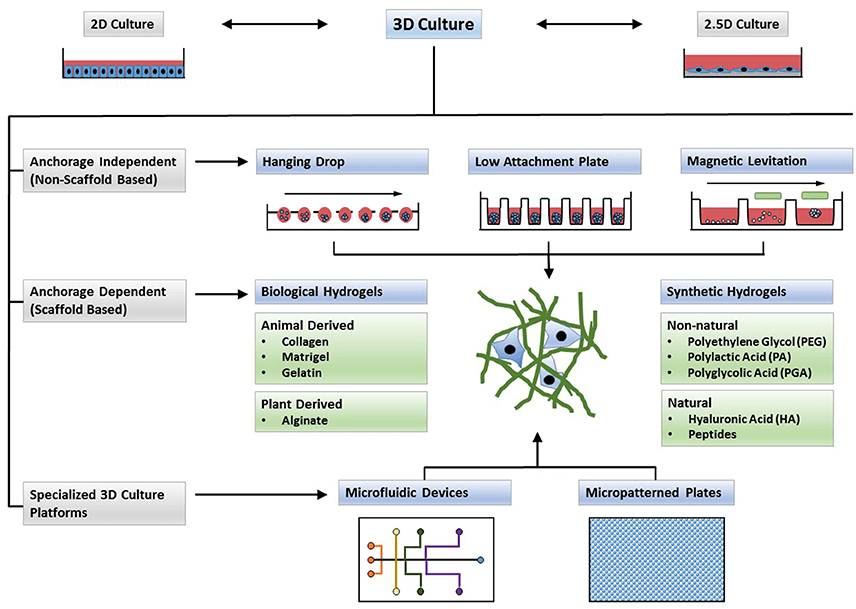Drug Interference Assay Services
Creative Bioarray selects high-quality 3D cell culture products to help customers build cell models that can be used for drug interference testing and toxicity analysis. The creation of functional heterogeneous co-cultures can be used for high-throughput testing by exposing primary cultured cell systems grown in supports or substrates to different levels of stimuli (eg growth factors, small molecules). After continuous adjustment and improvement, we have formed a mature internal optimization agreement, which can provide ideal cell models and fast-turnover drug interference analysis services according to your requirements.
3D In Vitro Cell Culture Models in Drug Discovery
As researchers understand the importance of extracellular matrix (ECM) in cell behavior, culturing cells in a three-dimensional (3D) system that mimics key tissue factors seems to be more beneficial than a two-dimensional (2D) monolayer membrane. The terminology representing the internal environment is gradually being recognized. Traditional 2D culture provides a lot of information about basic biology and disease processes, and most cell cultures used for drug discovery are also based on 2D monolayers of cells grown on a flat surface. ECM is a complex "mixture", including matrix proteins (such as collagen, elastin), glycoproteins, glycosaminoglycans, proteoglycans and other extracellular supports and other secreted proteins. The dynamic changes of these components regulate cell proliferation, differentiation, migration, survival, adhesion, and the role of cytoskeletal organization and cell signals in normal physiological development and many diseases. At present, most of the knowledge that ECM affects drug response and leads to drug resistance comes from research on cancer. Using the above-mentioned characteristics of 3D cell culture, a cell model for in vitro drug interference testing can be constructed.
 Fig 1. Types of 3D cultures. (Langhans S A, et al. 2018)
Fig 1. Types of 3D cultures. (Langhans S A, et al. 2018)
Drug Interference Assay Based on 3D Cell Culture Model
Our project can provide a variety of cell model construction methods based on 3D cell culture technology, including scaffold or matrix-based 3D culture methods. This service can provide testing services for researchers and drug developers who need drug interference testing and drug toxicity testing. We can provide customers with constructed 3D cultured cell models, customers will send us the interference drugs to be tested, and we will complete the follow-up drug interference analysis. Our molecular biology platform provides a variety of analysis tools such as cell viability, growth status, gene expression, metabolite analysis, cell imaging, etc., which can help customers complete the analysis of the impact of specified "stimuli" on cells. This service can accept cell model construction of primary cell culture systems, including skin culture systems (such as keratinocyte culture systems), vascular culture systems (such as smooth muscle cell culture systems) and other cell culture systems. We select high-quality 3D cell culture products to form an internally optimized experimental program to ensure that we provide customers with high-quality scientific research services.
 Fig 2. The workflow of drug interference analysis service based on 3D cell culture.
Fig 2. The workflow of drug interference analysis service based on 3D cell culture.
Creative Bioarray uses advanced D cell culture technology to construct primary cell line cell models, providing customers with convenient tools for drug interference, toxicity testing, and small molecule discovery. Our tested internally optimized cell model construction program can quickly and stably test the "drug" to be tested. Our experimental platform provides you with tailor-made drug interference solutions. If you are interested in this service, please feel free to contact us. We look forward to working with you in the near future.
Reference:
- Langhans S A. Three-dimensional in vitro cell culture models in drug discovery and drug repositioning[J]. Frontiers in pharmacology, 2018, 9: 6.
For research use only. Not for any other purpose.

 Fig 1. Types of 3D cultures. (Langhans S A, et al. 2018)
Fig 1. Types of 3D cultures. (Langhans S A, et al. 2018)  Fig 2. The workflow of drug interference analysis service based on 3D cell culture.
Fig 2. The workflow of drug interference analysis service based on 3D cell culture. 